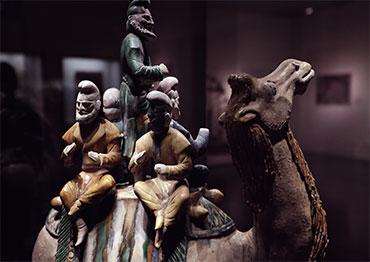China’s market economy and cultural development peaked during the Song Dynasty (960-1279). The Song included the Northern Song (960-1127) based in today’s Henan Province and the Southern Song (1127-1279) mainly ruling the area south of the Yangtze River. A very famous painting titled “Along the River during the Qingming Festival” by early 12th century artist Zhang Zeduan captures bustling market scenes in the capital Kaifeng during the last years of the Northern Song. Part of the Song’s prosperity is attributed to relaxed restrictions on business. Unlike the Tang, there were no walls or gates between residential communities, and curfews were lifted. These changes made interaction much easier. In the painting, there are shops and inns along the river and peddlers touting their wares. The 2018 period TV drama Minglan centers on a fictional love story set in the Northern Song that highlights the era’s nightlife. The heroine, Sheng Minglan, loves food. When she was unhappy, her husband would cheer her up by buying her favorite snacks or taking her out to dinner.
However, the Song was a far cry from a free market economy. The throne not only held monopolies over salt and steel but also expanded them to other daily commodities, including tea, alcohol and alum.
In the painting, a foreign merchant’s caravan is entering the capital. Unlike the Han and Tang, the Northern Song was not strong enough to keep the Silk Road safe, as it passed through two neighboring empires, the Western Xia (1038-1227) and Liao (916-1125). However, as the painting reveals, caravans from the West and Central Asia still played a major role in Song foreign trade. As a result, imperial-owned, private and foreign businesses were all important to the Northern Song market economy, where foreign merchants were the key players in foreign trade.
After the Northern Song was destroyed in 1127 by the Jin Dynasty (226-420), which was ruled by the Jurchens of the northern steppes, Gaozong, a brother of the Northern Song’s last emperor, Qinzong, founded a new dynasty south of the Yangtze River – the Southern Song. The region was the most prosperous in China at that time, economically, culturally and technologically. There were two important technological breakthroughs made during the Southern Song. One was the spread of movable type printing, and private printing houses quickly popped up to cater to a burgeoning market for print media. The other was the improvement of the compass for maritime navigation, making long-distance oceanic voyages possible. Compared with the Silk Road land routes, sea routes not only reached more cities, but made shipping more cost effective. They eventually replaced the Silk Road to make the Southern Song the world’s largest trade economy.
But independent Han private merchants were still sidelined in foreign trade during the Southern Song.
The port cities of Quanzhou in Fujian Province and Alexandria in Egypt were the largest in the world during the Southern Song. In July 2021, Quanzhou was included on the UNESCO World Heritage List as the starting point of the Maritime Silk Road. According to UNESCO, Quanzhou’s cultural sites “reflect in an exceptional manner the spatial structure that combined production, transportation and marketing and the key institutional, social and cultural factors that contributed to the spectacular rise and prosperity of Quanzhou as a maritime hub of the East and Southeast Asia trade network during the 10th-14th centuries.”
Two major players dominated foreign trade in Quanzhou during the Southern Song. One was the Pu family from the Middle East, and the other was the Song royal family.
Han-owned businesses were still excluded from foreign trade, a policy reinforced by neo-Confucianism. The school of thought, which became mainstream during the Southern Song, held conservative views on society and ethics. It was during this era that women’s foot-binding became widespread, and farmers still had a higher social status than businesspeople.
In addition, maritime trade cost a lot of money, and smaller Han-run businesses did not have the capital to invest.
During the Mongol-controlled Yuan Dynasty (1271-1368), business lost its stigma. But Han businesspeople, along with all other Han, were seen as inferior to the ruling Mongols, foreigners and other ethnic minorities of the dynasty.
After the Yuan, foreign trade was banned or highly restricted during the Ming and Qing dynasties (1368-1911). But in the late Ming of the 16th century, Han businesspeople enjoyed higher social status. Since the Southern Song, China’s economic and cultural centers shifted south, especially to the Yangtze River Delta, which today remains one of the most powerful engines of China’s economy. The area’s market economy boomed in the 16th century. Private businesses engaged in textiles, shipbuilding, oil extraction and other sectors. Even scholars who failed the imperial exam sought to join the business world. This was inconceivable before the 16th century, when poor scholars were much more revered than rich merchants.
Despite the improved social status of businesspeople, agriculture was still the top priority for the Ming and Qing dynasties, and passing the imperial exam was still a much better choice for scholars than business. When foreign trade was highly restricted and commerce was not respected, China’s market economy developed slowly.
However, during this time, the market economy was booming in the West, which would set the stage for the coming Age of Exploration and Industrial Revolution.

 Old Version
Old Version


